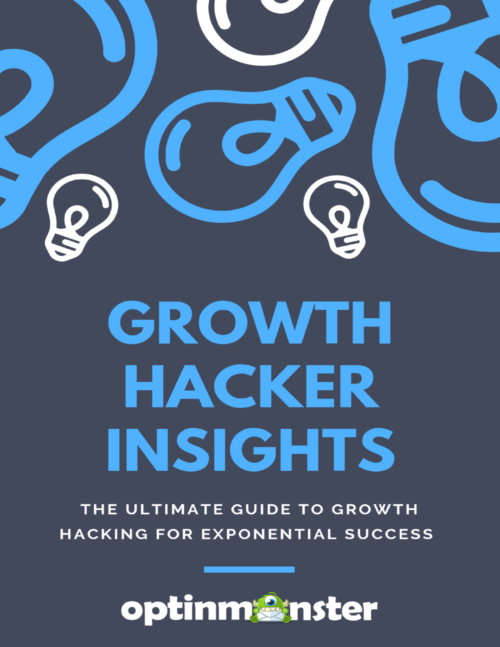Do you want to start selling digital products?
These days, it seems like everyone wants to add digital products to their business offerings, and for good reason. Selling digital products is often much cheaper and simpler than selling physical products. But how do you decide what sort of digital product to sell?
At OptinMonster, we’ve helped thousands of creators, entrepreneurs, and small businesses turn their ideas into profitable digital products.
In this article, we’re sharing 21 of the best digital products to sell.
Ready to build your first (or next) digital product? Let’s dive into the smartest opportunities available today.
🚀 Sell More Digital Products with OptinMonster!
Creating an amazing digital product is just the first step—but are you converting your visitors into buyers? With OptinMonster, you can boost your sales with high-converting popups, exit-intent offers, and targeted promotions that turn website traffic into paying customers.
✅ Grow your email list with irresistible lead magnets
✅ Recover abandoning visitors with exclusive discounts
✅ Increase conversions with time-sensitive flash sales
💡 Pro Tip: Use OptinMonster’s countdown timers to create urgency and drive more instant purchases!
🎯 Start selling more digital products today! Try OptinMonster Now →
What Are Digital Products?
Digital products are intangible items consumed or accessed digitally. Examples include ebooks, music, software, online courses, video games, apps, and movies. Unlike physical goods, they don’t require physical inventory and can be accessed anywhere via email, stream, or download.
Why Sell Digital Products?
There are several reasons why selling digital products can be a good idea:
- Wide reach: Digital products can be sold and delivered to customers anywhere in the world with an internet connection.
- Low overhead costs: Unlike physical products, you don’t have to worry about manufacturing costs, shipping expenses, or storage space for digital products. This keeps your profit margins high.
- Easy to scale: With digital products, you can easily reach a large audience without having to increase production costs. In most cases, the same digital file can be sold over and over.
- Versatility: Digital products can take many forms, such as e-books, courses, software, music, and more. This allows you to offer a variety of products to your customers.
- Continuous income: Digital products can generate continuous income through recurring billing, such as yearly software licenses or monthly membership fees.
- Passive income: Once you create a digital product marketing funnel, that funnel can earn money on autopilot without any further effort from you.
Because of these advantages, digital products are a great way to start your own online business. You can sell digital products as a side hustle alongside a job or other responsibilities, or grow it to a profitable full-time career.
Digital products are a useful lead generation strategy for service-based businesses. For instance, a wedding planner could sell a digital wedding planning template. Customers who buy the template are most likely planning a wedding, and thus the target audience for the wedding planner’s services.
Now let’s look at the different types of digital products
Types of Digital Products
Educational & Informational Products
These include content-rich products designed to teach or share knowledge, from ebooks and research reports to webinars and coaching sessions. They’re perfect for creators who want to monetize what they know and help others learn new skills or solve specific problems.
Templates & Tools
These are time-saving digital resources like Canva templates, Notion dashboards, and worksheets. They’re often plug-and-play solutions buyers can quickly customize and use, making them a great choice for entrepreneurs looking to sell simple, repeatable assets.
Creative & Media Products
This category includes visual and audio assets like stock photography, music, digital art, and sound effects. These products are ideal for artists, designers, and content creators who want to package their creative output into scalable digital goods.
Community & Recurring Revenue Models
These products focus on access and connection rather than one-time downloads. Think subscription newsletters and private membership groups. They’re excellent for building long-term relationships and generating steady, recurring income.
Software & Plugins
Digital tools like apps, themes, and browser extensions fall into this category. These products solve specific problems for users and often scale well — especially when offered with paid upgrades or recurring licenses.
What are some examples of digital products? In the next section, we go through some specific ideas from each category.
21 Best Digital Product Ideas and Examples
1. Ebooks
Ebooks are digital books you can sell online, usually as PDFs or ePub files. They can teach a skill, tell a story, or share your expertise in a structured way.

Nathan Barry, founder of ConvertKit, made over $250,000 selling his ebook “Authority,” teaching creators how to monetize their expertise online.
Takeaway:
You don’t need a massive audience — you need a clear, valuable message and a system to market it.
How to Create It:
Outline your topic, write the content using Google Docs or Word, and design it with tools like Canva. Export it as a PDF and you’re ready to sell.
Best For:
Coaches, bloggers, consultants, and anyone who wants to package what they know into a sellable asset.
2. Notion Templates
Notion templates are pre-built dashboards, planners, or productivity systems created inside the Notion app. Buyers can duplicate them to organize their work, school, or personal lives.

Thomas Frank, a productivity YouTuber, built a full business around selling Notion templates that help students and creators stay organized.
Takeaway:
Solving micro-problems with polished templates is a proven digital product model — especially if you already use the tool yourself.
How to Create It:
Design a helpful system inside Notion, publish it as a template link, and promote it through marketplaces like Gumroad or your own site.
Best For:
Entrepreneurs, productivity nerds, students, and freelancers who love optimizing workflows.
3. Canva Templates
Canva templates are ready-made designs for social media, presentations, resumes, and more. Customers buy them to customize quickly without starting from scratch.

Boss Project sells Canva template bundles for social media managers and small business owners, turning design shortcuts into consistent monthly revenue.
Takeaway:
Templates save busy entrepreneurs time — and time-savers always sell well.
How to Create It:
Design eye-catching templates in Canva, group them into bundles if you can, and sell the template links through Etsy or your website.
Best For:
Designers, marketers, virtual assistants, and content creators looking for passive income streams.
Real-World Example:
Unsplash contributors upload niche-specific, high-quality stock photos that are downloaded and licensed by businesses worldwide, building portfolios and getting visibility.
Takeaway:
High-demand niches (like business, food, wellness) can create ongoing opportunities for stock photographers.
4. Mini Online Courses
Mini-courses are short, focused online classes that teach a single topic or skill. Unlike big, expensive courses, they’re easier to create and sell fast.

Ali Abdaal, a YouTuber and entrepreneur, launched mini-courses like “How to Study for Exams” before scaling into bigger flagship programs.
Takeaway:
You don’t need a full 40-hour course to launch — focused, actionable mini-courses often perform better for beginners.
How to Create It:
Plan a 3–5 lesson course, record videos with Zoom or Loom, and upload them to platforms like Teachable, Podia, or Kajabi.
Best For:
Educators, coaches, consultants, and experts who want a low-barrier entry into online education.
5. AI Prompt Packs
AI prompt packs are curated collections of ready-to-use prompts for AI tools like ChatGPT, Midjourney, or Jasper. They help users get better results faster.

PromptBase allows creators to package and sell highly specific AI prompts for ChatGPT, Midjourney, and DALL-E users — creating a marketplace for AI-generated assets.
Takeaway:
The AI content revolution isn’t just about creating — it’s about packaging value into usable formats that save buyers time.
How to Create It:
Test different prompts in your favorite AI tools, organize them into categories, and package them as downloadable files.
Best For:
Marketers, content creators, solopreneurs, and AI early adopters who want to cash in on the AI boom.
6. Printables (Planners, Checklists, Worksheets)
Printables are digital downloads like planners, checklists, and worksheets that buyers can print at home. They’re quick, affordable products that help people stay organized.

The Budget Mom sells printable budget planners and checklists through her website, helping thousands manage their finances without physical inventory.
Takeaway:
Simple, practical printables can become powerful passive income streams — especially when tied to a real problem.
How to Create It:
Design useful layouts in Canva or Illustrator, export as PDFs, and sell them on Etsy, Gumroad, or your website.
Best For:
Teachers, life coaches, parents, and anyone offering organization or productivity tools.
7. Stock Photos
Stock photos are high-quality, royalty-free images that businesses, bloggers, and designers use for their content and marketing.

Unsplash contributors upload niche-specific, high-quality stock photos that are downloaded and licensed by businesses worldwide, building portfolios and getting visibility.
Takeaway:
High-demand niches (like business, food, wellness) can create ongoing opportunities for stock photographers.
How to Create It:
Take niche-specific photos, edit them professionally, and upload them to platforms like Shutterstock or sell them directly.
Best For:
Photographers, hobbyists, and visual storytellers.
8. Music or Sound Effects
Music tracks and sound effects are downloadable audio files creators use in videos, games, podcasts, and ads.

Epidemic Sound started by offering royalty-free music for YouTubers and expanded into a full-blown licensing powerhouse.
Takeaway:
Good original audio sells — especially with creators needing background music for videos, podcasts, and ads.
How to Create It:
Record original sounds or songs, edit them for clarity, and distribute them through marketplaces or your own store.
Best For:
Musicians, sound designers, and audio engineers.
9. Mobile App Templates
Mobile app templates are pre-designed app frameworks that developers can customize and launch faster.

Creative Tim sells mobile UI kits and app templates that help developers build projects faster without starting from scratch.
Takeaway:
Templates that save time and reduce complexity are in huge demand among developers.
How to Create It:
Build starter templates using frameworks like Flutter or React Native, and sell them on CodeCanyon or your site.
Best For:
Developers and freelance app builders looking for passive income streams.
10. Lightroom Presets
Lightroom presets are custom photo editing filters that users can apply to photos with one click inside Adobe Lightroom.

Jaci Marie Smith, a lifestyle photographer, sells branded Lightroom presets to her Instagram audience, turning her photography style into a product.
Takeaway:
If you have a unique aesthetic, you can monetize it by offering “ready-to-use” editing shortcuts.
How to Create It:
Create and fine-tune presets, export them, and bundle them for sale on marketplaces or your website.
Best For:
Photographers, influencers, and content creators focused on visuals.
11. Website Themes

Website themes are pre-designed templates for WordPress, Shopify, and Squarespace sites that make building a website faster and easier.
StudioPress (makers of the Genesis Framework) built a multimillion-dollar business selling WordPress themes for bloggers and entrepreneurs.
Takeaway:
Good design paired with clean code creates endless opportunities in the theme market — especially for niche industries.
How to Create It:
Design responsive, visually appealing themes, package them properly, and list them for sale.
Best For:
Web designers, developers, and creative entrepreneurs.
12. Fonts
Fonts are custom-designed typefaces that designers and businesses buy to enhance their branding and marketing materials.

Jessica Hische, a famous lettering artist, built a large part of her brand by creating and licensing her own custom fonts.
Takeaway:
Unique fonts aren’t just for designers — they’re branding assets that businesses will pay a premium for.
How to Create It:
Use software like Glyphs or Fontself to create a full alphabet set, export the font files, and license them.
Best For:
Graphic designers, hand letterers, and branding experts.
13. Subscription Newsletters
Subscription newsletters deliver curated or original content directly to subscribers’ inboxes, often with a free tier and a paid premium tier.

Lenny Rachitsky’s newsletter (“Lenny’s Newsletter”) on Substack earns over $500K/year from paid subscriptions in the product management niche.
Takeaway:
If you deliver high-quality insights consistently, subscription newsletters can become standalone businesses.
How to Create It:
Choose a niche, set a regular publishing schedule, and start building your list on platforms like Substack or ConvertKit.
Best For:
Writers, journalists, thought leaders, and niche curators.
14. Membership Communities
Membership communities are exclusive online groups where members pay to access content, events, or a private network.

Pat Flynn of Smart Passive Income built SPI Pro, a premium membership for entrepreneurs — creating a stable, recurring revenue stream.
Takeaway:
When you build community around transformation, not just content, people are willing to pay for access.
How to Create It:
Set up a private space on platforms like Circle or Slack, offer value like events, resources, and coaching, and charge a recurring fee.
Best For:
Coaches, entrepreneurs, hobbyists, and influencers with an engaged following.
15. Software Tools or Plugins
Software tools and plugins are downloadable programs or add-ons that extend the functionality of apps like WordPress, Shopify, or browsers.

MonsterInsights (sister brand to OptinMonster!) built a hugely successful business around a simple WordPress plugin for Google Analytics.
Takeaway:
Solving one real-world pain point can lead to massive, scalable digital product success.
How to Create It:
Identify a specific problem, build a simple tool to solve it, and sell licenses or subscriptions.
Best For:
Developers, SaaS founders, and engineers.
16. Webinars (Paid or Free + Upsell)
Webinars are live or pre-recorded online seminars that teach a topic and often lead to an upsell like a course, service, or product.

Amy Porterfield built her multimillion-dollar business by hosting free webinars that seamlessly led into her course sales.
Takeaway:
A free webinar that solves a real problem can be the best sales funnel you’ll ever build.
How to Create It:
Create a slide deck, schedule a session, deliver valuable training live or via replay, and offer a natural next step.
Best For:
Coaches, consultants, service providers, and B2B experts.
17. Digital Art
Digital art is original artwork created using digital tools, sold either as downloads or printed products.

Loish, a digital artist, monetizes her illustrations through Patreon, art books, and downloadable art packs.
Takeaway:
Artists no longer need galleries — building a digital audience gives you direct control over your income.
How to Create It:
Design using Procreate, Illustrator, or Photoshop, then sell as digital prints or via print-on-demand platforms.
Best For:
Artists, illustrators, and creatives ready to monetize their work.
18. Online Coaching Sessions
Online coaching sessions are personalized, real-time meetings where you help clients achieve goals, solve problems, or learn skills.

Marie Forleo started with online life coaching sessions before scaling into courses and a media empire.
Takeaway:
If you can help someone get a result faster, coaching is one of the fastest digital products to launch.
How to Create It:
Set clear coaching packages, schedule sessions via Zoom or Calendly, and deliver transformative results.
Best For:
Business coaches, life coaches, health coaches, and consultants.
19. Worksheets for Teachers
Educational worksheets are printable resources that teachers and parents use to supplement student learning.

Deanna Jump, an early seller on Teachers Pay Teachers, became a millionaire selling printable worksheets and lesson plans.
Takeaway:`
Helping teachers save time with ready-to-use resources is an evergreen niche with constant demand.
How to Create It:
Align your worksheets to educational standards, design them in Canva or Docs, and sell them on Teachers Pay Teachers.
Best For:
Educators, curriculum developers, and homeschooling parents.
20. Audiobooks
Audiobooks are spoken-word recordings of books that listeners can enjoy hands-free while commuting, exercising, or relaxing.

James Clear, author of “Atomic Habits,” sells his audiobook alongside his print and Kindle versions — adding a major revenue stream.
Takeaway:
Offering multiple formats (print, ebook, audiobook) increases reach and maximizes product value.
How to Create It:
Record your book or hire a narrator, edit for clarity, and distribute through platforms like Audible and iTunes.
Best For:
Authors, bloggers, and storytellers.
21. Research Reports
Research reports are detailed analyses or studies sold to businesses, entrepreneurs, or professionals needing niche insights.

CB Insights sells deep-dive industry research reports to tech investors, startups, and corporate strategy teams.
Takeaway:
If you can gather and organize valuable insights faster than others, people are willing to pay top dollar.
How to Create It:
Compile original research or data analysis into a professional PDF and sell as a one-time download or subscription.
Best For:
Analysts, marketers, SaaS experts, and industry researchers.
FAQs About Selling Digital Products
1. What is the most profitable digital product?
The most profitable digital products in 2025 are online courses, software tools or plugins, and membership communities. These products offer recurring revenue, high perceived value, and scalable delivery. For example, a mini course can be sold hundreds of times with zero additional fulfillment, while a WordPress plugin or coaching membership can generate consistent monthly income. The key to profitability is solving a clear problem and building systems for automation and marketing.
2. How do I start selling digital products?
To start selling digital products:
- Choose a product type (e.g., ebook, course, template).
- Create the product using tools like Canva, Notion, or Loom.
- Pick a selling platform such as Shopify, Gumroad, or WordPress.
- Build an audience via email, blog content, or social media.
- Launch with a lead magnet or discount offer to drive first sales.
Using a tool like OptinMonster helps capture leads and increase conversions with popups, countdown timers, and exit-intent offers—crucial for turning traffic into buyers.
3. What is the most popular digital content?
The most popular digital content types right now are:
- Ebooks — Easy to create and accessible across devices
- Canva & Notion templates — Time-saving tools that sell fast
- Mini online courses — Bite-sized education with high impact
- AI prompt packs — A rising star thanks to tools like ChatGPT
These formats are favored because they’re quick to launch, scalable, and beginner-friendly—making them ideal for creators, marketers, and small business owners alike.











Add a Comment